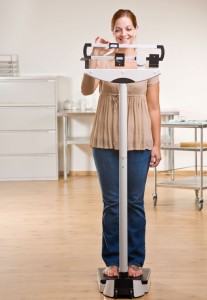 According the U.S. Centers for Disease Control and Prevention, two-thirds of Americans are overweight or obese with one-third falling into the obese category. With 49 states having obesity rates surpassing 20 percent, it’s clearly a call to action. However, we need to move away from numbers on a scale and move towards understanding our body composition. It’s more important for your clients to know their body fat percentage, how much excess fat they are carrying around, than how much the scale says they weigh. Health risks rise with excess body fat and the chances of falling and injury increase with reduced muscle mass. Body composition is critical to accurately assess a client’s condition.
According the U.S. Centers for Disease Control and Prevention, two-thirds of Americans are overweight or obese with one-third falling into the obese category. With 49 states having obesity rates surpassing 20 percent, it’s clearly a call to action. However, we need to move away from numbers on a scale and move towards understanding our body composition. It’s more important for your clients to know their body fat percentage, how much excess fat they are carrying around, than how much the scale says they weigh. Health risks rise with excess body fat and the chances of falling and injury increase with reduced muscle mass. Body composition is critical to accurately assess a client’s condition.
The human body consists of a variety of components; generally, when we talk about body composition, we consider fat mass and lean mass (i.e. non-fat). For better health and appearance you want to have significantly more lean mass than fat mass. All bodies need some fat to survive. Fat aides in nerve conduction, cushions organs and insulates. Too much fat increases the risks of heart disease, stroke, diabetes and joint injuries. About 20 percent of body fat in men and 30 percent in women is considered obese. A healthy body fat percentage for men is between 12 and 20 percent and for women it is between 16 and 25 percent.
Clients need to understand that just dropping pounds isn’t an indicator of good health. Teaching clients that they must lose excess fat and increase lean muscle mass is key. A healthy program of diet and exercise can often result in an increase on the scale, but a decrease in overall body fat percentage. Muscle weighs more than fat, when muscle starts replacing fat mass, weight can stay the same or go up. A thin person isn’t necessarily a healthy person. A low calorie diet with no exercise typically results in muscle loss before fat loss. While a scale may indicate a lower-body weight, the person’s percentage of body fat may change very little. Muscle is good; it actually burns fat — even at rest. Educate: more muscle equals more calories burned. Muscle is also critical for controlling motion and balance. For the elderly, it is particularly important to maintain regular exercise as well as diet to keep a healthy body composition.
To help clients meet their goals, a program combining a good, balanced diet with regular cardio and strength training exercises will result in more muscle and less fat. Having the ability to track your client’s body fat percentage, fat loss and muscle gain will go far to motivate and increase success.
Many methods are available to measure body fat percentage, such as skin fold calipers which measure fold thickness with known formulas to estimate body fat percentage. Bioelectrical impedance devices can also estimate body fat percentage, but hydration, alcohol and caffeine levels may affect the accuracy. Underwater weighing and air displacement systems are accurate, but require expensive equipment and client preparation. DEXA, X-ray Computed Tomography and Magnet Resonance Imaging provide accurate images that can be used to not only measure total body composition but also show fat distribution. Distribution is important because it allows you to differentiate between subcutaneous and visceral fat. Unfortunately, these systems are expensive and not practical for regular tracking. Ultrasound imaging has long been used in clinical settings as a non-invasive means of measuring tissue structure. Portable, affordable hand-held ultrasound imaging devices are now available to accurately measure overall body composition as well as provide point specific measurements of fat and muscle thicknesses. These ultrasound devices provide clients with images that clearly show changes in fat and muscle. If a client is dieting and exercising, they will see fat layers getting thinner and muscle growing. These images can be more motivating and informative than mere numbers on a scale.
The goal is to change bodies and mindsets. Not all weight is created equal — numbers on a scale don’t matter when the weight is primarily from lean muscle mass. Education, diet, exercise and accurate assessment tools can help everyone reach their healthy potential.





